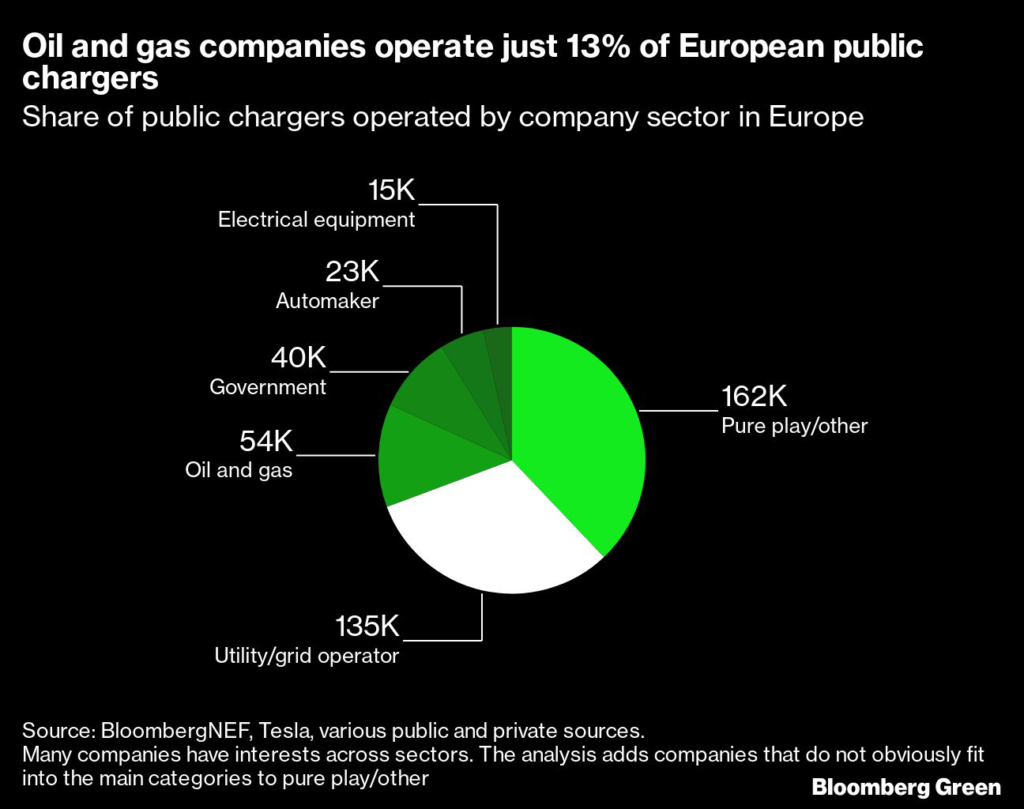(Bloomberg) — Stay on top of the electric car revolution by signing up to our Hyperdrive newsletter here.
A bird’s eye view of electric vehicle charging infrastructure globally reveals a battle being fought for market share across many sectors – utilities, oil and gas, autos, retail, infrastructure, telecoms and more. For all these, EV charging offers an opportunity to diversify and grow. But the prospects are less optimistic for the world’s major oil and gas companies, who are defending their current share of the fuel market.
Oil and gas companies are lagging in the public charging market. According to BNEF research, they operate less than 1% of public chargers in China, 2% in the U.S. and 13% in Europe. Different dynamics are at play in each region. In China the government has provided a clearer path to state-owned utilities. In the U.S., the major oil and gas companies have so far shown less interest in most things green as reflected by BNEFs Oil & Gas Transition Scores. Also, there is limited EV charging activity compared with Europe, where major companies have sizeable renewable energy portfolios.
But several acquisitions and recent announcements offer some promise of boosting these companies’ shares in the various EV markets in the coming decade. Shell and BP, with charging operations in Europe, the U.S. and China, have set ambitious roll-out targets. Over the past five years, Shell has acquired a range of charging start-ups — lamp-post charging provider Ubitricity, New Motion in Europe, and Greenlots in the U.S., among them — and it has formed a partnership with China’s BYD. It aims to operate 500,000 chargers globally by 2025.
BP has signed several deals, including the acquisitions of U.K. provider Chargemaster and U.S. fleet charging company Amply Power. And it’s part of a joint venture with Didi in China and software provider Digital Charging Solutions. BP says it expects to install 70,000 chargers globally by 2030.
These and other efforts are an attempt to replace future losses in fuel revenues, which are likely to be slashed due to the cheaper cost of electricity and increased EV efficiencies; also, about 50% of sales will be lost due to home and depot charging.
Ultra-fast charging for passenger vehicles and fleets, following on their gas station model, are priorities for both BP and Shell. But even those plans fall short. BP plans to install 8,000 chargers across 4,000 BP and Aral gas stations in Europe — that comes to two chargers per station, barely a blip compared to the ten plugs at Tesla supercharger stations. The limited approach won’t persuade consumers that this is convenient for them, and the maintenance costs could prove high given the fewer number of chargers per site.
There’s also a question about whether retrofitting gas stations with chargers is the right strategy for the oil and gas companies. The existing network might not offer the best locations for chargers going forward, especially as retail charging is expanding. Supermarkets have had success in this market. Many, including Walmart and German supermarket chain REWE, along with a bunch of other retailers and restaurants like McDonalds, are installing ultra-fast chargers. Drivers might pop into a local gas station now and then, if it’s their only option. But for longer charge times, say 20-40 minutes, it likely would be more appealing to go to a supermarket, shopping center or restaurant to plug in while running other errands.
Oil and gas companies are picking up on these trends. Shell has installed a nine bay ultra-fast charging station in London and has signed a deal with Waitrose to install chargers — albeit slower 22-50kW ones — across stores in the U.K. Even so, the road ahead won’t be a straight one — they will have to get creative to win over the charging market and diversify across the supply chain.
Like getting this newsletter? Subscribe to Bloomberg.com for unlimited access to trusted, data-driven journalism and subscriber-only insights.
More stories like this are available on bloomberg.com
©2022 Bloomberg L.P.











